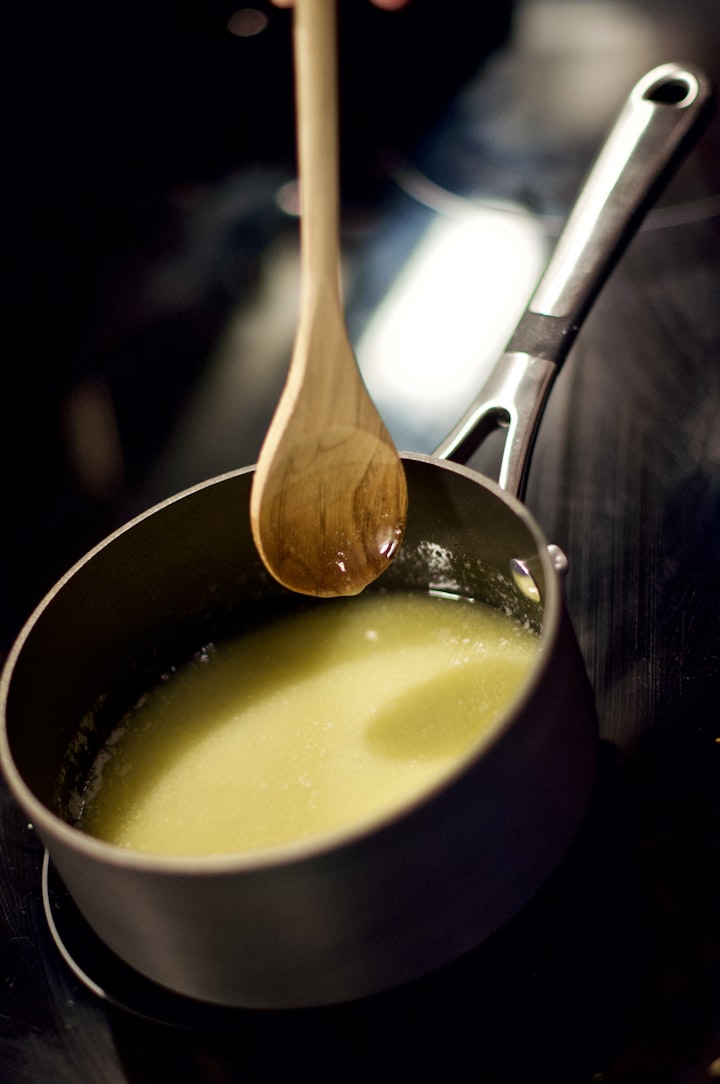Butter, Butter Everywhere with Crucial Cholesterol
...why take away margarine's bad trans fats from my table

What if “we have been conned into believing margarine was better for us than butter. Now scientific evidence is totally at odds with decades of official advice ... Why swap it for margarine, a highly synthetic and unpleasant-tasting concoction laced with additives and cheap, low-grade oils refined on an industrial scale? “ Dr. Joseph Mercola: Butter is Booming
Butter is dear and near to my heart because of Daisy, a beloved Jersey cow on our farm who for years supplied my mother with fresh rich milk that would be separated into cream for butter and skim milk for cottage cheese. My job was to churn the cream in a large glass container until yellow chunks began to gradually emerge from the buttermilk. The sweet butter would be removed, washed and pressed into pound shapes with wooden frames to be sold as fresh farm butter for a dollar.
Of course, our family’s pancakes swam in butter, until there came a time when my mother decided that tubs of margarine were better than butter according to so many happy Moms’ accolades in advertisements and commercials.
Enjoy Heart-Healthy, Great Tasting Food That’s Good For You And Good For Our Planet! Made With Plant-Based Oils & No Artificial Preservatives.
And, so it was through decades, when more and more health officials may have wrongly urged consumers to avoid healthy fats like butter to reduce their risk of heart disease and lose weight; to eat, spread and cook with margarine, made with refined vegetable oils and trans fats.
Nobody explained to Mom the dangers of trans fats or why healthy doses of cholesterol found in butter were actually crucial to a healthy diet.
Do you know why your body needs some fat or cholesterol from food?
Cholesterol is a waxy fat made in- the liver that is vital to human life. It is present in every cell of the body with natural functions as a major source of energy:
...helps absorb some vitamins and minerals and generates Vitamin D
...builds essential cell membranes, the vital exterior of each cell, and the sheaths surrounding nerves
...helps blood clotting, muscle movement, and is anti-inflammatory
There are two types of cholesterol:
...low-density lipoproteins (LDL), or “bad” cholesterol that can harden arteries and cause blood clots
...high-density lipoproteins (HDL), or “good” cholesterol that helps to remove bad LDL back to the liver to be eliminated
You can get cholesterol through foods. Since it can’t be created by plants, you can only find it in animal products like meat and dairy.
Difference between Trans Fats and Saturated Fats
Trans-fats ... are industrial products through a hydrogenation process that blasts more hydrogen atoms to turn oils (unsaturated fats ) into solids to prevent them from becoming rancid
Trans fats are the worst artery clogging fat that increases harmful LDL cholesterol and reduces beneficial HDL cholesterol that leads to inflammation which is linked to heart disease, stroke, diabetes, and other chronic conditions such as insulin resistance.
The Food and Drug Administration (FDA) ruled in 2015 that manufacturers should phase these out of products over the following 5 years.
Saturated fats ... are solid at room temperature — examples: red meat, whole milk, cheese, coconut oil
Is saturated fat bad for you?
On one hand, a diet rich in saturated fats can drive up total cholesterol, and tip the balance toward more harmful LDL cholesterol, which prompts blockages to form in arteries in the heart and elsewhere in the body. For that reason, most nutrition experts recommend limiting saturated fat to under 10% of calories a day.
On the other hand, what if common assumption is wrong?
“Butter isn’t bad for you; in fact, it’s healthy, being high in vitamins, beneficial saturated fats, the sort of cholesterol that is vital for brain and nervous system development and various natural compounds with anti-fungal, anti-oxidant and even anti-cancer properties.”
Tell Me More about Butter
One tablespoon contains 102 calories, 11.5 g of fat, 7.17 g of saturated fat and 30.5 milligrams of cholesterol
Butter is derived from dairy and is rich in saturated fats which helps to increase LDL cholesterol and not affect HDL. Its nutritional value depends on how the animals are raised, as the fatty acid composition of butterfat varies according to the animal’s diet.
When buying butter, try to choose grass-fed varieties, preferably organic. In countries where cows eat grass, butter consumption has associations with a dramatic reduction in heart disease risk. This may be because grass-fed dairy products are much higher in omega-3 fatty acids, which are important for heart health.
Nutrients in Butter include:
Vitamin A, Lauric acid, Lecithin — necessary for cholesterol metabolism and nerve health
Antioxidants, Vitamin E, Vitamin K2, Vitamin D
Minerals, including selenium, manganese, chromium, zinc, and copper
Iodine in a highly absorbable form
Cholesterol … crucial to healthy body
Tell Me More about Margarine
One tablespoon contains 102 calories, 11.5 g of fat and 2.16 g of saturated fat
Margarines aren’t easy to classify because they use different recipes but some still contain trans fats; the more solid the margarine, the more trans fat it has. The older stick margarines turned out to be clearly worse but some of the newer margarines are lower in saturated fat, higher in unsaturated fat, and free of trans fats.
Margarine can be made using unsaturated fats like olive oil, flaxseed oil, and fish oil in the production process that can contain a range of ingredients such as salt, Vitamin A and other compounds like maltodextrin, soy lecithin, and mono or diglycerides.
Because of such varied recipes, different health impacts can result. Look for margarine with the lowest amount of trans fat, preferably 0 grams and check the ingredients label for partially hydrogenated oils.
Some types of margarine contain plant compounds called phytosterols made from a blend of oils, such as olive oil or flaxseed oil.
Phytosterols are similar in structure to cholesterol. As a result, they compete with cholesterol for absorption in the body, reducing how much cholesterol the body absorbs. This may bring down levels of natural blood cholesterol with possible harmful effects on the walls of blood vessels.
Controversial research
Controversies and differing medical perspectives about whether butter is more or less healthful than margarine are still common enough. However, there appears to be a growing body of scientific opinion believing that there was never any good evidence linking intake of dietary saturated fats with blocked coronary arteries and heart disease.
Studies show that both the cheese and butter test diets increased LDL cholesterol more than the other low fat, high carbohydrate test diets, a high polyunsaturated fat plan, and a plan high in monounsaturated fat.
However, there was no impact on markers of inflammation, blood pressure, or insulin or glucose levels between all of the tested diets.
Analyzed results from multiple studies have concluded that there is no high quality evidence to support the effectiveness of a diet higher in unsaturated fats for preventing or treating heart disease.
Studies show that refined vegetable oils are among the worst foods to consume, and a prominent study released in 1997, which examined the effects of margarine on cardiovascular disease, revealed that margarine increases your heart attack risk.
Still, for decades margarine remained more popular than butter; it wasn’t until 2005 that butter regained its top title, and consumption has been on the rise ever since.
Your choice is personal
Each individual will respond differently to dietary fats based on their current health status, lifestyle, genetics and overall nutritional patterns.
People who need to follow a weight-controlled diet should manage total calorie intake that can up with regular use in larger servings with both butter and margarine.
Use moderate amounts of both butter and margarine, or alternate with grass-fed butter, that might allow a person to reap the benefits of both without contributing to excessive total fat intake.
Use creative alternatives with which to replace butter and margarine in baking such as avocado, applesauce, pumpkin puree, nut butters, Greek yogurt and mashed banana.
Personally, I will continue using butter on my toast and getting my quotient of cholesterol because I recently read that cholesterol helps an aging brain!
What is your opinion about the controversy between butter and margarine?
What are some of your favorite ways to use butter?
Questions and comments are always appreciated ...
To your good health,
Annemarie Berukoff
About the Creator
Annemarie Berukoff
Experience begets Wisdom: teacher / author 4 e-books / activist re education, family, social media, ecology re eco-fiction, cultural values. Big Picture Lessons are best ways to learn re no missing details. HelpfulMindstreamforChanges.com






Comments
There are no comments for this story
Be the first to respond and start the conversation.